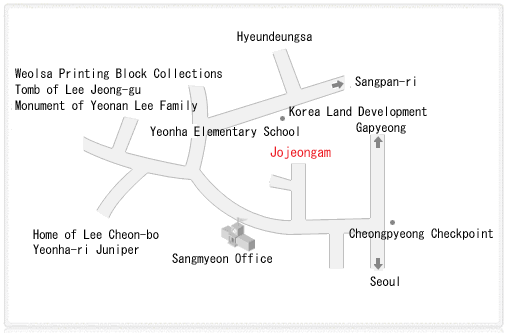
- Eight Scenes of Gapyeong
- Treasures
- Hyeundeungsa 3-story Stone Pagoda
- Weolsa Printing Block Collections
- Hyeundeungsa 3-story Jijin Pagoda
- Icheonbogoga (Ancient House)
- Jojongam
- General Lee Bang-sil Tomb
- Yeonhari Juniper
- Tomb of Lee Jung-goo
- Jijang Jangyonghun
- Bongseonsa Bell at
Hyeondeungsa - Hyeundeungsa Suweolganeumdo
- Hyeundeungsa Hamheodangdeuktongtap and
Stone Lanterm
- Monument
- Memorial Monument
- Monument for the Participation of the British Commonwealth in the Korean War
- Yongmunsan Battle Monument
- Monument for the Participation of Canada in the Korean War
- Monument for the Participation of New Zealand in the Korean War
- Monument for the Participation of Australia in the Korean War

Home > Culture/Tourism > Treasures > Jojongam
Treasures
Jojongam

Location: Daebo-ri, Hamyeon
Management Organization: Wang Jong-nak ( 031-585-1281)
Designation No.: Provincial Monument 28
Designation Date: September 5, 1975
Information
Jojongam depicts all the stone inscriptions, tombstones and platform remains. The tombstones are erected right in front of these stones and there is a daetongmyo for holding sacrificial rites near it. In front of this, the clean and clear Jojongcheon (Riv) flows along the mountain bends.
It is said that in the 10 th year of Sukjong in the Joseon Dynasty, Wooam Song Si-yeol inscribed Samusa , which was from the handwriting of the king of the Ming and also inscribed quotes from Hyojong, according to his request to Lee Jae-doo, at the designated location.
Accordingly, various scholars such as Lee Jae-doo, Heo Gyeok and Park Hae-myeong came together to inscribe passages from their forefathers and hold sacrificial rites.
The reason why Jojongam was erected here was because of Jojongcheon (Riv.). The Korean meaning of Jojong is that several rivers come together to become a sea and also is symbolic of feudal lords having audiences with the emperor. Therefore, this location was established to become a place of worship.
Traffic Information
Public Transportation
[Train] Board Chuncheon-bound train from Cheongnyangni Station and get off at Cheongpyeong
[Bus] Ride Chuncheon-bound bus from Donseoul Terminal or Sangbong Terminal and get off at Cheongpyeong
[City Bus] Board Hyeonri-bound bus at Cheongpyeong Terminal and get off at Hyeonri and take bus to Daebo-ri




































